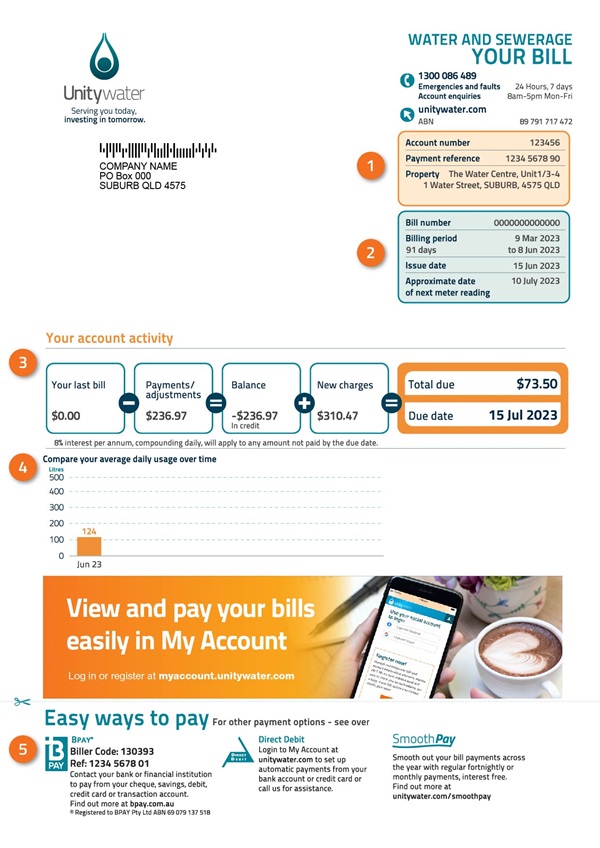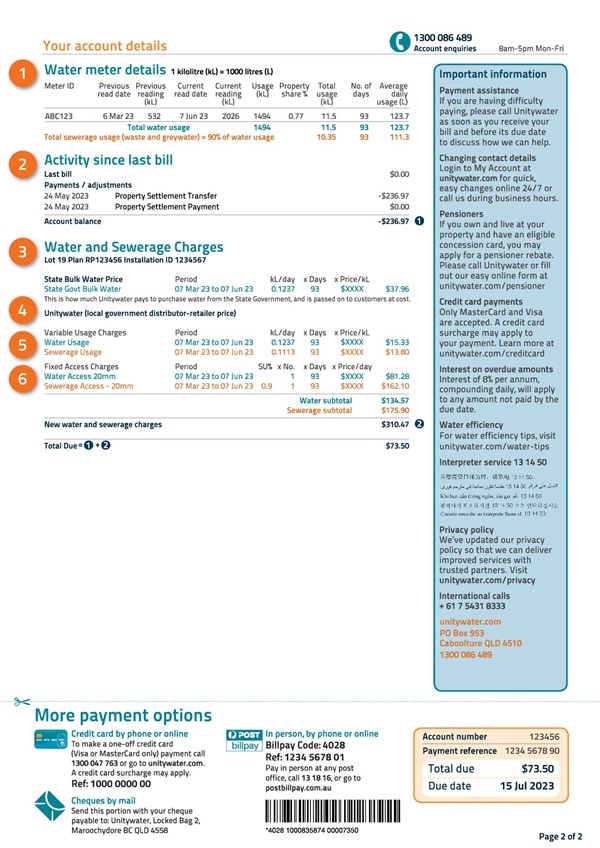For business customers who have recently taken ownership of a property
Our bill guide is designed to help you understand your bill and monitor your water usage.
Page 1 of your first bill

Your guide to reading page 1 of your first bill
Account number
Use this number to register for My Account and keep it handy if you need to contact us for assistance.
Payment reference
Use this when paying your bill – if you have more than one property, each property will have its own reference number.
Property
This is the property address that is being billed. This may be different to your postal address.
Need to change your postal address?
Bill number
This is a unique number that helps you identify each individual quarterly bill we send to you.
Billing period
We read your property's water meter and issue your bill every three months, on roughly the same dates in each quarter. This quarterly billing cycle is set by your property's location and does not change when the property's ownership changes.
If your property settlement occurred part way through the quarterly billing cycle, this means the billing period for your first bill will start prior to the settlement date and will include charges for the time that the previous owner was still at the property. Don't worry, these outstanding charges should've been taken care of by your conveyancer during settlement. Refer to 'Your account activity' for more details. Also read more about this on our buying a business or commercial property page.
Approximate date of next meter reading
Please make sure your water meter is clear and accessible around this time so we can read it.
Learn how to read your water meter so you can:
- take your own reading and compare it to the the reading printed on your meter reading notice (PDF 169KB) to make sure they are the same (this helps to ensure the meter reader has recorded your meter reading correctly)
- be proactive and check for any leaks early.
Your account activity
This is a summary of any payments or adjustments made since the last bill for this property, plus the new charges for this billing period and the amount due for payment.
Your last bill
As this is your first bill for this property, this amount is $0.00.
Payments/adjustments
This will include any outstanding charges from the previous billing period, less any payments received during the property settlement.
Payments received during the property settlement are to cover the seller’s portion of charges for the period up until the settlement date.
Your conveyancing solicitor normally determines the settlement payment amounts and will be able to answer any questions you may have regarding this calculation.
A breakdown of these amounts is shown on Page 2 under 'Activity since last bill'.
Balance
This represents the balance after settlement and often shows a credit as a result of the settlement payment from the seller.
New charges
This shows all of the new charges applied for this billing period and will include charges for the time that the previous owner was still at the property.
Total due
This is the total of the new charges less the payments and adjustments.
Compare your average daily usage over time
The average daily usage is for the entire billing period of your first bill, so it is an average of both the previous owner's usage and your own usage. Over time, you will be able to compare and track your own water usage with prior billing periods.
View our water efficiency tips to help you reduce your water use.
Easy ways to pay
We’ve listed some of the easiest ways to pay on the front page for your convenience. Other payment options are listed on Page 2.
Find out more about our bill payment options.
Page 2 of your first bill

Your guide to reading page 2 of your first bill
Previous read date and previous reading
This shows the date and total amount of water in kilolitres (kL) recorded for this property at the start of this billing period.
Current date and current reading
This shows the date and total amount in kilolitres (kL) recorded for this property at the end of this billing period. Billing periods are usually 90 days but may vary by several days either way.
Usage (kL)
This is the total amount of water in kilolitres (kL) used during this billing period and is the 'Current reading (kL)' minus the 'Previous reading (kL)'.
This total will include some usage from the previous owner, which means the daily average usage may not be a true indication of your household’s daily average water usage.
Average daily usage (L) is calculated by dividing your total usage by the number of days in the billing period.
Please note: 1 kilolitre (kL) = 1000 litres (L)
Property share %
If you have purchased a unit in a complex, you may see 'Property share %' on your bill to show the lot entitlement for the unit (the percentage of total water usage a unit has to pay according to the Body Corporate agreement). The total usage will represent the percentage in kilolitres for the unit.
Property settlement transfer
This is the amount of the seller's outstanding charges from previous billing periods that were still owing on the property prior to the settlement date.
Property settlement payment
This shows any amounts that were paid as part of the settlement process, including the amount calculated as the seller’s portion of charges for the current billing period.
Account balance
This is the balance of your account prior to the charges for this billing period being applied. A negative account balance means the seller has paid some of the charges from this billing period through the settlement process and your account is in credit.
This shows a breakdown of all your variable usage and fixed access charges:
Lot / Plan / Installation ID
Non-residential properties have a Lot and Plan number for each legal parcel of land that makes up the property. The Installation ID is Unitywater’s unique identifier for each lot, or parcel of land. Most non-residential properties only have one; however, if the property is made up of multiple lots, there will be a different Lot, Plan and Installation ID number for each one.
State bulk water price
This is the amount the State Government charges Unitywater to purchase water to supply to our customers. We are legally required to pass this cost on in full to our customers, and all revenue raised from bulk water charges is passed back to the State Government. Bulk water is charged per kilolitre of water used.
More information on pricing for your region.
Unitywater (local government distributor-retailer price)
Unitywater’s charges for water and sewerage usage and fixed water and sewerage access. See Variable Water Usage Charges and Fixed Access Charges for more details.
More information on pricing for your region
Water usage charge
Water usage is a variable charge because it is based on the amount of water that is consumed at your property, and is charged per kilolitre of water used.
Sewerage usage charge
Sewerage usage is a variable charge because it is based on the amount of water used at your property. As there is no meter to measure the amount of sewage, it is calculated based on water usage multiplied by a sewerage usage percentage based on theproperty land use type.
Sewerage usage may differ depending on industry type and water usage. A property sewerage usage percentage can be reviewed for a fee.
Please note : 1 kilolitre (kL) = 1000 litres (L)
More information on pricing for your region
Fixed access charges
These charges are for your property having access (connected or unconnected) to the water and sewerage network. They pay for building, maintaining and replacing water supply and sewerage infrastructure, including pipes, pumps and sewage treatment plants. If you have purchased vacant land in an area that is serviced by the water and/or sewerage network, you will be billed for fixed access charges for that property.
Access fees are fixed, annual fees charged at a daily price for the number of days in your billing period.
Non-residential properties may have multiple meter access charges.
